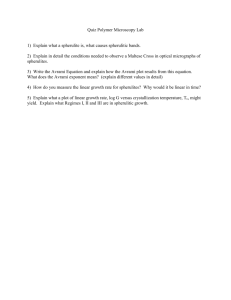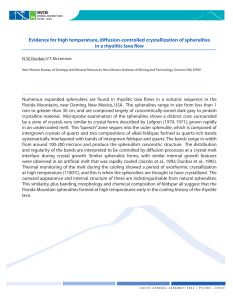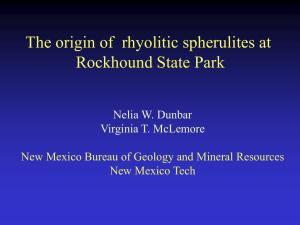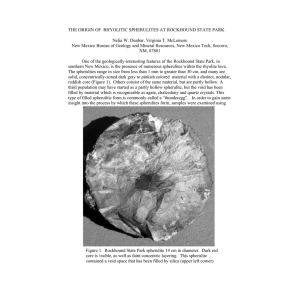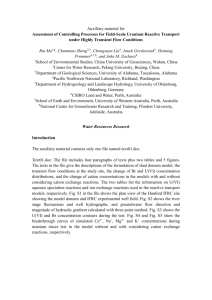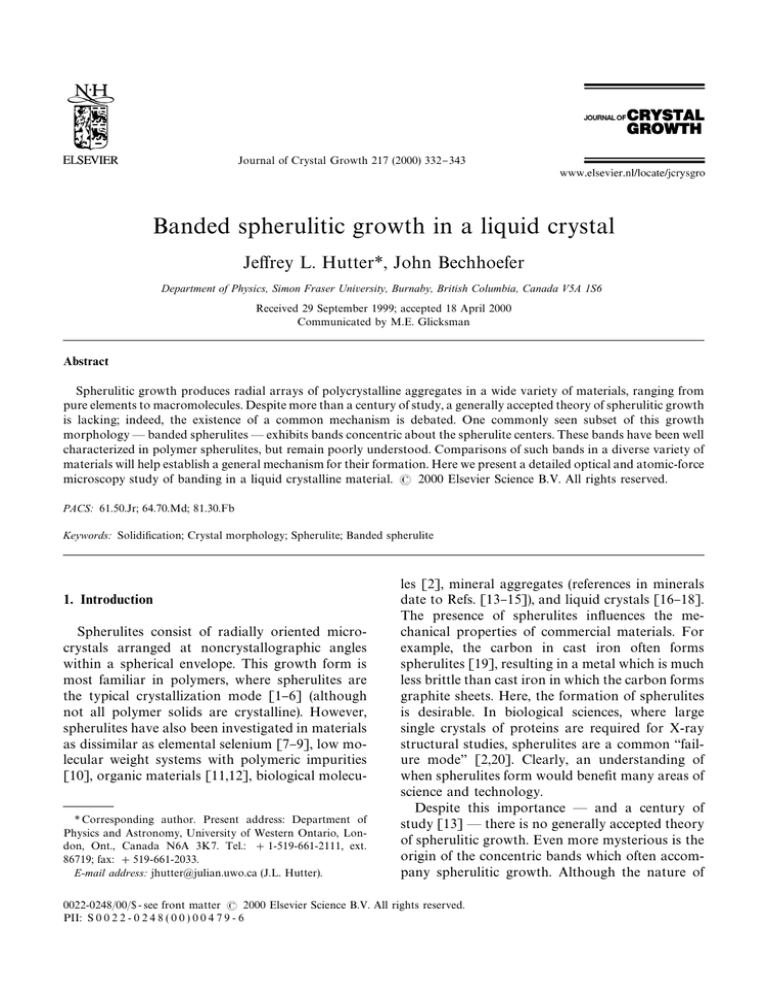
Journal of Crystal Growth 217 (2000) 332}343
Banded spherulitic growth in a liquid crystal
Je!rey L. Hutter*, John Bechhoefer
Department of Physics, Simon Fraser University, Burnaby, British Columbia, Canada V5A 1S6
Received 29 September 1999; accepted 18 April 2000
Communicated by M.E. Glicksman
Abstract
Spherulitic growth produces radial arrays of polycrystalline aggregates in a wide variety of materials, ranging from
pure elements to macromolecules. Despite more than a century of study, a generally accepted theory of spherulitic growth
is lacking; indeed, the existence of a common mechanism is debated. One commonly seen subset of this growth
morphology * banded spherulites * exhibits bands concentric about the spherulite centers. These bands have been well
characterized in polymer spherulites, but remain poorly understood. Comparisons of such bands in a diverse variety of
materials will help establish a general mechanism for their formation. Here we present a detailed optical and atomic-force
microscopy study of banding in a liquid crystalline material. 2000 Elsevier Science B.V. All rights reserved.
PACS: 61.50.Jr; 64.70.Md; 81.30.Fb
Keywords: Solidi"cation; Crystal morphology; Spherulite; Banded spherulite
1. Introduction
Spherulites consist of radially oriented microcrystals arranged at noncrystallographic angles
within a spherical envelope. This growth form is
most familiar in polymers, where spherulites are
the typical crystallization mode [1}6] (although
not all polymer solids are crystalline). However,
spherulites have also been investigated in materials
as dissimilar as elemental selenium [7}9], low molecular weight systems with polymeric impurities
[10], organic materials [11,12], biological molecu* Corresponding author. Present address: Department of
Physics and Astronomy, University of Western Ontario, London, Ont., Canada N6A 3K7. Tel.: #1-519-661-2111, ext.
86719; fax: #519-661-2033.
E-mail address: jhutter@julian.uwo.ca (J.L. Hutter).
les [2], mineral aggregates (references in minerals
date to Refs. [13}15]), and liquid crystals [16}18].
The presence of spherulites in#uences the mechanical properties of commercial materials. For
example, the carbon in cast iron often forms
spherulites [19], resulting in a metal which is much
less brittle than cast iron in which the carbon forms
graphite sheets. Here, the formation of spherulites
is desirable. In biological sciences, where large
single crystals of proteins are required for X-ray
structural studies, spherulites are a common `failure modea [2,20]. Clearly, an understanding of
when spherulites form would bene"t many areas of
science and technology.
Despite this importance * and a century of
study [13] * there is no generally accepted theory
of spherulitic growth. Even more mysterious is the
origin of the concentric bands which often accompany spherulitic growth. Although the nature of
0022-0248/00/$ - see front matter 2000 Elsevier Science B.V. All rights reserved.
PII: S 0 0 2 2 - 0 2 4 8 ( 0 0 ) 0 0 4 7 9 - 6
J.L. Hutter, J. Bechhoefer / Journal of Crystal Growth 217 (2000) 332}343
333
Table 1
Properties of 10OCB
Quantity
Symbol
Value
Units
Ref.
Chemical name
Formula
Molecular weight
Chemical abstracts no.
Density (solid)
Viscosity (SmA)
Thermal di!usivity (SmA)
Speci"c heat (SmA)
Latent heat of solidi"cation
Solid}smectic A transition
Smectic A}isotropic transition
*
*
*
*
o
g
D
F
c
N
¸
¹ }
) 1
¹
1\'
4}cyano}4}decyloxybiphenyl
C H ON
335.49
70247-25-5
1.098
&0.2}1
&10\
&2
115
59.5
84
*
*
g/mol
*
g/cm
Pa s
cm/s
J/g 3C
J/g
3C
3C
*
*
*
*
[28]
[31]
[31]
Viscosity data for a similar compound, 8OCB, have been measured as a function of temperature by K. Negita [29].
Thermal di!usivities of similar compounds are given by U. Zammit et al. [30].
BDH Limited, Broom Road, Poole, BH12 4NN, England.
these bands is known in some systems (for instance,
in polymers the bands are associated with a periodic rotation of the optical axis along the spherulite
radius [1}3,21,22]), the mechanism responsible for
their formation remains elusive.
The striking similarity of spherulites in diverse
systems suggests a corresponding similarity in
growth mechanisms. If a common mechanism
exists, comparison of spherulitic growth in dissimilar materials can identify those features that are
fundamental to such a mechanism. Here, we compare and contrast both banded and unbanded
spherulites solidi"ed from a liquid crystalline material with those grown from other systems. In the
following section, we motivate the choice of material studied and describe the experimental techniques used. In Section 3, we discuss the general
features of the spherulites formed and compare
with other spherulitic systems. Section 4 presents
studies of the growth dynamics. We conclude with
a discussion of implications for the general mechanism of spherulitic growth.
Despite the striking simularities between spherulites in diverse systems, proposed models of spherulite banding are often
speci"c to polymers, implying that the phenomenon may be
material speci"c. See Refs. [23,24].
2. Experimental procedure
We chose to study spherulitic solidi"cation of the
liquid crystalline material 4}cyano}4}decyloxybiphenyl (10OCB). In previous publications
[18,25}27], we described the wide variety of growth
morphologies exhibited by 10OCB, and showed
that transitions between these morphologies occur
at well-de"ned growth temperatures and are accompanied by sharp changes in growth properties
such as the growth velocity and front shape. This
system is experimentally convenient: it is available
in quite pure form, it is chemically stable, and its
properties are well known (see Table 1).
The `intermediatea properties of liquid crystals
result in natural growth velocities between those of
simple molecular systems, which often grow too
quickly to allow detailed observations, and those of
macromolecular systems, which typically freeze at
inconveniently slow rates [32]. Spherulitic growth
in 10OCB occurs at approximately room temperature and with velocities of the order of 100 lm/s.
The 10OCB is nominally pure, but does contain 0.15%
water at the saturation limit. Samples prepared by heating under
vacuum to remove volatile impurities, as well as samples doped
with &2 mol% C Cl , showed the same solidi"cation behav ior, suggesting that the morphologies are not impurity driven.
334
J.L. Hutter, J. Bechhoefer / Journal of Crystal Growth 217 (2000) 332}343
The samples consisted of thin (10 lm) layers of
10OCB sandwiched between two glass plates. We
used thin (&170 lm) plates to ensure rapid cooling
to the desired temperature. A typical solidi"cation
experiment begins by melting the sample into the
isotropic phase on a hot plate. The sample is then
quickly transferred to a computer-controlled hot
stage set to the desired undercooling. The sample
quickly enters a supercooled smectic phase, after
which the solid phase nucleates. Spherulitic growth
was observed for temperatures less than approximately 403C, corresponding to undercoolings greater
than approximately 203C.
We studied the solidi"cation front using optical
microscopy, recording the images with a video
camera and frame grabber. The front location
and shape were determined by applying a threshold
to the images and selecting the pixels dividing the
darker solidi"ed material from the melt. We
tracked the motion of this front to determine its
velocity.
We also used optical microscopy to observe
spherulitic growth in directional solidi"cation [33].
In a directional solidi"cation experiment, the
sample is driven at a constant velocity through
a temperature gradient produced by a narrow gap
between two temperature stages. The temperature
di!erence is set so that the solidi"cation front is
visible within the gap. After an initial transient
when the sample motion begins, the front approaches a steady state which is stationary within
the lab frame, allowing the front to be studied for
a period of time set by the sample dimensions.
Finally, the microstructures of the samples were
studied using an atomic-force microscope (AFM)
HS1-i Microscope Hot Stage and Temperature Controller,
Instec, Inc., Boulder, CO 80306.
Olympus BH-2 Olympus Optical Company, Lmt., Tokyo,
Japan.
Pulnix TM-7CN, Pulnix America, Inc., Sunnyvale, CA
94086.
Scion LG-3, Scion Corporation, Frederick, MD 21701.
Image processing was performed using the software package
NIH Image, v. 1.61. National Institute of Health, Division of
Computer Research and Technology, USA The procedure is
described in more detail in Ref. [27].
Universal AFM/STM. Park Scienti"c Instruments, Sunnyvale, CA 94089-1304.
after solidi"cation was complete. The sandwich
cells described above could be pried apart, usually
resulting in cleavage along one of the plates. Such
cleavage did not alter the visual appearance of the
spherulites; in addition, AFM images of samples
prepared without a top plate exhibited similar
topography.
3. Classical spherulitic growth in 10OCB
In this section, we examine the properties of
10OCB spherulites and show that they exhibit features associated with spherulites in other systems.
3.1. Spherulites are round
Observations of spherulitic growth usually reveal
that the growing solid phase de"nes a slowly expanding spherical envelope within a viscous #uid.
One qualitative di!erence between the system
studied here and more familiar spherulite forming
systems is that growth proceeds from a smectic
liquid crystalline phase, rather than from an isotropic melt. Not surprisingly, solidi"cation from an
ordered phase can result in anisotropic growth. For
most of our experiments, we treated the glass plates
with an organosilane to impose homeotropic anchoring with the smectic layers parallel to the surfaces, thus creating a uniform, defect-free sample.
This removes the anisotropy in the sample plane
and results in round spherulites.
Experiments performed with cells treated for
planar anchoring (i.e., with smectic layers perpendicular to the surfaces) resulted in spherulites that
di!ered only in the growth anisotropy: the growth
was slowest in the anchoring direction, resulting in
oval `spherulitesa with an aspect ratio of &0.9, as
shown in Fig. 1. We achieved this anchoring by
slowly (&1 mm/min) drawing the plates from
a beaker containing a polyimide solution to obtain
a thin polymer layer with molecules aligned in the
drawing direction, baking at 1503C to remove
the solvent, and gently rubbing with a "ne cloth in
ZLI 2510, E. Merck, Darmstadt, Germany.
J.L. Hutter, J. Bechhoefer / Journal of Crystal Growth 217 (2000) 332}343
Fig. 1. Oval spherulite in a planar-anchored sample. The scale
bar measures 100 lm.
the drawing direction. The resulting plates force the
liquid crystal molecules to align along the drawing
direction, resulting in smectic planes perpendicular
to this direction. Since this anchoring causes faster
growth in the direction of the smectic planes, it is
possible that molecules aligned tangentially to the
spherulite front are more easily incorporated into
microcrystals. Other than the oval shape, there is
no obvious di!erence between spherulites formed
in planar and homeotropic anchoring. In the remainder of this paper, we consider homeotropic
anchoring only.
3.2. Spherulites consist of radial arrays of
microcrystals
Aside from the spherical (or circular, in two dimensions) shape of spherulites, the classical
characteristic of this growth morphology is a radial
orientation of microcrystals. The cause of this
orientation is unknown and may be system-dependent. One way to achieve such a noncrystallographic radial alignment is to impose a pressure
between neighboring crystallites. In polymers,
which form ribbon-like lamellae, Bassett, Keller,
and Misuhashi [6,34,35] have proposed that this
pressure is an entropic pressure due to dangling
polymer chains in the gap between lamellae. Such
a model cannot apply to materials formed from
smaller molecules. In such cases, Tiller [36] has
335
Fig. 2. Collection of spherulitic domains viewed through crossed polarizers. Note the characteristic `Maltese crossa pattern,
indicating a 3603 rotation in crystal orientation about the nuclei,
and the concentric bands due to rotation of the optic axes about
this radial direction (by 1803 for each band). The scale bar
represents 25 lm.
suggested that the splay is due to viscous #ow of the
melt induced by the density change during solidi"cation. Flow through the narrow channels separating adjacent needle crystals (towards the center of
the spherulite, if the solid is more dense than the
liquid) will generate a pressure according to the
Hagen}Poiseuille equation.
Although the microscopic mechanism of splay is
quite di!erent for the two cases discussed above,
both predict a radial arrangement of initially parallel crystals caused by crystal bending (or breaking,
if the mechanical strain is great enough). Since this
requires the orientation of the crystals to vary with
angular position about the spherulite center,
spherulites often exhibit a `Maltese crossa pattern
when viewed through crossed-polarizers [3]. As
shown in Fig. 2, this pattern is observed for 10OCB
spherulites. Here, dark bands concentric with the
nucleus are also seen. The AFM allows us to image
the radial orientation directly (cf. Fig. 8 below).
There is good evidence for a density change and
resultant #ow during the growth of 10OCB
spherulites. We estimated the change in density by
measuring the change in size of small droplets
(200}800 lm in diameter) sandwiched between
glass plates held 25 lm apart as they are solidi"ed.
Since the solid phase is denser than the smectic A,
336
J.L. Hutter, J. Bechhoefer / Journal of Crystal Growth 217 (2000) 332}343
Fig. 3. Density change during solidi"cation of a small droplet of
10OCB at an undercooling of 30 3C between glass plates 25 lm
apart. The density change causes the droplet to shrink. The
original shape is still visible because of a thin (estimated from the
depth of focus to be &1 lm) "lm of material which freezes to
the glass plates. The scale bar spans 200 lm.
the drops shrink during solidi"cation, as shown in
Fig. 3. Note that the solid drop is not perfectly
circular because the solid phase does not usually
nucleate at the center. This results in increased #ow
from the regions further from the nucleus. We
found that the density change is approximately
10% for spherulitic growth, although the thin "lm
of material left on the plates as the droplet shrinks
makes a precise estimate di$cult. We will see that
the spherulitic morphology is not compact on the
microscopic scale. Thus, this density change must
be regarded as an average value over the spherulite
domain, and is not representative of the intrinsic
volume change for the phase transition.
Fig. 4. Evolution of the `sheaf-likea spherulite nucleus.
of wheat. The standard explanation [14,37] is that
the spherulite initially nucleates as a single needle,
from which new needles branch. As the spherulite
gets larger, the needles are forced into a radial
orientation. If there is a maximum branching angle
and/or minimum radius of curvature, the result is
an asymmetric nucleus with two cavities which are
inaccessible to crystals branching from the original
nucleus, and a defect line where needles from opposite ends of the nucleus meet. This process is shown
schematically in Fig. 4.
10OCB spherulites also exhibit this sheaf form,
as shown by the AFM images in Fig. 5, which are
also complicated by concentric bands. Occasionally nuclei are seen with a spiral banded structure, rather than the sheaf form (Fig. 6). These may
result from nucleation at heterogeneous sites such
as dust particles.
3.3. Spherulite nuclei
3.4. Banded spherulites
A model of microcrystals radiating from a central nucleus requires a defect at the origin. Highresolution studies of spherulite nuclei reveal a pattern known in the literature as a `sheaf of wheata
morphology, due to its resemblance to a tied sheaf
Most of the spherulites discussed in this paper
are banded. Banding in spherulites is generally
accepted to be due to a birefringent e!ect
[1}3,21,22]. Observations suggest that the optical
J.L. Hutter, J. Bechhoefer / Journal of Crystal Growth 217 (2000) 332}343
337
Fig. 5. AFM micrographs of spherulite nuclei with sheaf structures.
Fig. 6. Spherulite nucleus with a spiral structure.
axis of the crystallites follows a helical path about
the spherulite radius. When viewed through crossed polarizers, dark bands are seen at radii where the
optical axis lies along the line of sight. This hypothesis is supported by an apparent shift in band
position when the sample is tilted, thus rotating the
optic axis about the tilt axis.
Twist in the unit cell orientation has been con"rmed in some systems by electron microscopy
[1,2,6,38,39], microbeam X-ray di!raction [40],
and micro-Raman spectroscopy [41]. The existence
of this twist can be due either to a continuous twist
of individual crystallites or to a dependence on
radius of the average orientation of (untwisted)
crystals. The second possibility is generally believed
more likely [2,39]. However, some electron micrographs of polymer spherulites indicate that the
lamellae are #at throughout most of the band, with
the twist occurring over a relatively short distance
[2,6,39].
Fig. 7 shows an optical micrograph of a portion
of a large spherulite. The center of the spherulite is
far outside the "eld of view, resulting in bands that
are nearly planar on the scale of the image. Note
that sharp phase shifts occur along the bands, resulting in lines perpendicular to the bands separating regions of coherent banding. AFM images (Fig.
8) show that these phase shifts are discontinuous at
the scale of the microcrystals which make up the
spherulite.
If we view spherulites illuminated by unpolarized
light through a single polarizer, we "nd that the
band contrast is greatest when the polarizer is aligned parallel to the bands. When the polarizer
passes light polarized perpendicularly to the bands,
the contrast is so weak that the bands cannot be
338
J.L. Hutter, J. Bechhoefer / Journal of Crystal Growth 217 (2000) 332}343
Fig. 7. Optical micrograph of a domain of banded spherulitic
growth. Note that the structure is divided into sub-domains
separated by phase shifts in the bands. This sample was solidi"ed at an undercooling of about 403C, resulting in a band
spacing of 1.7 lm. The scale bar measures 50 lm.
distinguished. This indicates that the contrast depends on an attenuation (by scattering, since absorption is negligible in the visible for 10OCB) of
the component of light polarized along the bands.
This supports the picture of an optical axis that
rotates about the spherulite radius (i.e., about the
long axes of the microcrystals) * such a rotation
does not alter the refractive index in the radial
direction, so that light polarized in the radial direction encounters no variation in refractive index and
produces no contrast.
We used the AFM and scanning electron microscope (SEM) to study the structure of the bands on
length scales of the band spacing and smaller. As
seen in Fig. 8, the bands are composed of individual
needle crystals approximately 600 As wide. Di!erent
banded domains are separated by discontinuities in
the band phase, as discussed earlier. The apparent
separation of bands within a single domain is not as
readily understood.
Fig. 8b shows many of the needle crystals ending
at well-de"ned band edges. Fig. 8a, however, does
not show such clear boundaries and contains examples of needles which extend across more than one
band. In neither case is the AFM resolution sharp
enough to reveal a twist in the needle crystals. It is
important to realize that the image measured by
Fig. 8. Atomic-force micrographs of spherulitic bands. The samples were grown between glass plates, which were subsequently
pried apart. The bands are composed of radially oriented
needles with lengths on the order of the band spacing. (a)
Spherulite grown at *¹"253C. (b) Spherulite grown at
*¹"323C. Note the sharp change in band phase.
the AFM is a map of the sample height required to
maintain a constant de#ection force on the cantilever. As such, the image contains both topographical and mechanical information [42]. For instance,
a soft region of the sample is di$cult to distinguish
from a depression in the surface. The fact that
bands can be seen in these images indicates that
they are associated with a modulation in either
sample height or sti!ness.
J.L. Hutter, J. Bechhoefer / Journal of Crystal Growth 217 (2000) 332}343
Fig. 9. Scanning electron microscope image of a banded
spherulite. The image shows a fractured spherulite with bands
visible on both the surface and fractured edge. The growth
direction was to the lower left.
339
Fig. 10. Growth velocity as a function of undercooling in the
spherulitic regime. The transition between unbanded and
banded spherulites occurs at &223C, with banded spherulites
at larger undercoolings.
4. Spherulite growth
A modulation in sample sti!ness could arise
from a twist in the average orientation of microcrystals: anisotropy in the mechanical properties of
the needle crystals would result in a variation in
sample sti!ness across each band. It is perhaps
more likely that the bands seen with the AFM
represent a real surface buckling that occurs after
cleavage to relieve stresses. Below, we present evidence for the existence of stress in 10OCB
spherulites.
In order to examine the bands inside the domains, we used the SEM to image freshly fractured
spherulite edges. We prepared the spherulites for
the SEM study on a highly doped silicon wafer to
provide a conducting substrate. Both the silicon
and glass cover plate were treated for homeotropic
anchoring. After removal of the glass plate, the
spherulite was fractured to provide fresh surfaces
revealing the interior banding structure. An
example is shown in Fig. 9. To avoid sample damage and charging e!ects we accelerated the electron
beam through a relatively small potential (1 kV)
and carefully adjusted the current so that the
incident #ux was balanced by electrons emitted
from the sample. The bands are clearly visible
throughout the sample bulk. This image also
shows some isolated needle crystals that have
detached from the spherulite. As with the AFM
images, these crystals have lengths of the order
of a band spacing.
Having established that the 10OCB spherulites
show all of the features seen in spherulites of other
materials, we turn our attention to the variation of
these features with growth conditions.
4.1. Growth velocity and band spacing
In previous publications, we examined
transitions between 10OCB growth morphologies
as a function of undercooling. Unlike the other
transitions studied, the unbanded to banded
transition is not accompanied by a sharp change in
growth velocity, although as shown in Fig. 10, the
velocity curve does undergo an unusual excursion
in this vicinity (at &223C). We found that other
quantities such as the band spacing and measures
of #uctuations (for instance the band coherence
length) do appear to diverge at the transition.
We also measured the band spacing of
spherulites grown by directional solidi"cation. The
undercoolings for these domains were not measured (accurate measurement of undercooling in
directional solidi"cation is di$cult), but the isothermal and directional solidi"cation results can be
compared on a plot of band spacing vs. growth
velocity. Fig. 11 compares the band spacing for
isothermal growth at a variety of sample thicknesses and directional solidi"cation in an imposed
temperature gradient.
340
J.L. Hutter, J. Bechhoefer / Journal of Crystal Growth 217 (2000) 332}343
4.2. Dependence of bands on local features
The fact that the band spacing has the same
dependence on growth velocity for di!ering conditions implies that the details of di!usion "elds and
Fig. 11. Spherulite band spacing as a function of growth velocity. Note that both sets of data * isothermal growth with
sample thicknesses ranging from 10 to 50 lm and directional
solidi"cation with an applied gradient of 503C/mm * fall onto
a single curve.
other long-range properties are unimportant to the
banding mechanism. This conclusion is further
strengthened by observations of growth in very
small domains. Examples are shown in Fig. 12. The
large droplet in Fig. 12a shows a spherulite with
a nucleation point at the top edge. The banded
domain was able to propagate to the lower section
of the droplet through an isthmus only a few band
spacings wide. Fig. 12b shows several instances of
banding in domains whose total extent is only a few
band spacing. These results indicate that the banding mechanism depends only on properties on the
length scale of the banding.
Occasionally, a growing spherulite would encounter an air bubble within the sample. The result,
as shown in Fig. 13, is a domain which is unperturbed save near the end of the bubble furthest from
the spherulite origin, where the bands bend around
the far side of the bubble (this e!ect has also been
discussed in polymeric spherulites [43]). This again
demonstrates the insensitivity to all but very local
perturbations.
Fig. 12. Spherulitic growth in small and irregular droplets. The bands are able to propagate through features with sizes of the order of
the band spacing. In addition, banding is seen in droplets only two bands across. The scale bar of 25 lm applies to both images.
J.L. Hutter, J. Bechhoefer / Journal of Crystal Growth 217 (2000) 332}343
Fig. 13. Spherulitic growth around an air bubble. Note that the
bands are unperturbed until forced to "ll in the region behind
the bubble. Growth was to the upper right and the scale bar
spans 25 lm.
4.3. High-speed observations
High-resolution real-time observations of
banded spherulite growth would aid in the development of a growth mechanism. The growth of
10OCB is too rapid to allow AFM investigations.
Instead, we studied the growth using high-speed
(up to 5000 frames/s) video microscopy. One of the
objectives of this approach was to determine
whether or not the front velocity oscillates with the
banding. Such an oscillation would be incompatible with a continuous twist of microcrystals, for
instance. While some of our observations did reveal
such an oscillation, we saw no clear trend with
undercooling (indeed, some runs showed no oscillation at all). Thus, the apparent oscillation was most
likely an e!ect of the band contrast * advance of the
front is more di$cult to see during phases when the
band has low contrast with the surrounding melt.
341
Fig. 14. Fracture of banded spherulites. Within a period of
hours, 10OCB spherulites often crack along the bands. Radial
cracks originating at the nucleus are also seen. A scale bar of 200
lm is shown.
ing since they are grown far from equilibrium. In
fact, spherulites of some materials can break up
with explosive force [4]. Our 10OCB spherulites
often fracture concentrically along the bands (see
Fig. 14) within a period of hours, indicating a builtin mechanical stress.
Over a period of several days, the bands disappear completely. This process can be accelerated by
heating the spherulites. Annealing at a few degrees
below the melting point causes the bands to disappear in a matter of moments. A well-de"ned front
associated with this change can be seen in Fig. 15a.
In this example the `unbandinga front had a velocity of &10 lm/s. Examination of the microstructure after the destruction of the bands, Fig. 15b,
shows that a change in morphology has occurred:
the microcrystals have become much larger and all
remnants of the band ordering have vanished (compare with Fig. 8). X-ray di!raction shows that the
crystal structure, or at least orientation, has also
changed.
4.4. Spherulite stability
5. Conclusions
Although banded spherulites are stable enough
to allow them to be studied, 10OCB spherulites are
not stable at room temperature. This is not surpris-
Spherulitic growth is a little-understood growth
morphology frequently seen in a diverse range of
342
J.L. Hutter, J. Bechhoefer / Journal of Crystal Growth 217 (2000) 332}343
Fig. 15. Annealing of banded spherulites. (a) `Unbanding fronta sweeping toward the center of the spherulite. This image was taken after
a few minutes of annealing &53C below the melting point. (b) AFM micrograph of a spherulite after the front in (a) has passed. Note
that the bands are no longer present.
materials. The similarity of spherulites in these differing materials suggests a common growth mechanism. We have studied spherulitic growth in a
liquid crystalline material with the goals of identifying the features shared by other spherulites and
studying the growth kinetics in an experimentally
convenient system.
Our spherulites, in common with those seen in
other materials, are composed of radially oriented
microcrystals originating from a sheaf-like nucleus
and growing with a front that is smooth on a scale
larger than the individual crystals.
Our observations of banded spherulites grown in
temperature gradients and in small and irregular
domains show that only properties very near the
growth front are important * sample conditions
only a few band wavelengths from the front are not
important. This dependence on local properties
gives hope that a simple model may be found.
Other hints are provided by the evidence (such as
the diverging band spacing shown in Fig. 11) that
the transition to the banded regime is analogous to
a second-order phase transition and occurs in a region where the front velocity is a decreasing function of undercooling (Fig. 10) [26,27].
Many careful microscopic studies of spherulitic
growth in a variety of materials exist in the litera-
ture. Further studies of their growth kinetics, particularly near the transition to the banded regime,
would be of great use in developing a universal
theory of spherulitic growth.
Acknowledgements
This work was funded by NSERC (Canada). The
authors would like to thank Tom Pinnington and
Robin Coope for the SEM micrograph shown in
Fig. 9, Tom Mason for the use of a high-speed
video camera, and Mike Degen and Matthew Case
for help in analyzing the images.
References
[1] P.J. Phillips, Rep. Prog. Phys. 53 (1990) 549.
[2] P.J. Phillips, Spherulitic crystallization in macromolecules,
in: D.T.J. Hurle (Ed.), Handbook of Crystal Growth, Vol.
2, Elsevier, Amsterdam, 1993 (Chapter 18).
[3] A. Keller, J. Polym. Sci. 17 (1955) 291.
[4] H.D. Keith, F.J. Padden Jr., J. Appl. Phys. 34 (1963) 2409.
[5] G. Schuur, J. Polym. Sci. 11 (1953) 385.
[6] D.C. Bassett, CRC Crit. Rev. Solid State Mater. Sci. 12
(1986) 97.
[7] G. Ryschenkow, G. Faivre, J. Crystal Growth 87 (1988)
221.
J.L. Hutter, J. Bechhoefer / Journal of Crystal Growth 217 (2000) 332}343
[8] J. Bisault, G. Ryschenkow, G. Faivre, J. Crystal Growth
110 (1991) 889.
[9] M. Mohan, A.K. Singh, Philos. Mag. B 67 (1993) 705.
[10] R.R. Lagasse, J. Crystal Growth 140 (1994) 370.
[11] J.H. Magill, D.J. Plazek, J. Chem. Phys. 46 (1967) 3757.
[12] F.P. Price, A. Keith Fritzsche, J. Phys. Chem. 77 (1973)
396.
[13] P. Iddings, Am. J. Sci. 33 (1887) 36.
[14] H.W. Morse, J.D.H. Donnay, Am. Mineral. 21 (1936) 391.
[15] P.J. Heaney, A.M. Davis, Science 269 (1995) 1562.
[16] F. Rinne, Trans. Faraday Soc. 29 (1933) 1016.
[17] S.C. Jain, S.A. Agnihotry, V.G. Bhide, Mol. Cryst. Liq.
Cryst. 88 (1982) 281.
[18] J.L. Hutter, J. Bechhoefer, Physica A 239 (1997) 103.
[19] B. Miao, D.O. Northwood, W. Bian, K. Fang, M.H. Fan,
J. Mater. Sci. 29 (1994) 255.
[20] A. Ducruix, R. GiegeH (Eds.), Crystallization of Nucleic
Acids and Proteins: A Practical Approach, Oxford University Press, Oxford, 1992.
[21] H.D. Keith, F.J. Padden Jr., J. Polym. Sci. 31 (1958) 415.
[22] A. Keller, J. Polym. Sci. 39 (1959) 151.
[23] H.D. Keith, F.J. Padden Jr., Polymer 25 (1984) 28.
[24] A.J. Owen, Polymer 38 (1997) 3705.
[25] J. Bechhoefer, J.L. Hutter, Physica A 249 (1998) 82.
[26] J.L. Hutter, J. Bechhoefer, Phys. Rev. Lett. 79 (1997)
4022.
[27] J.L. Hutter, J. Bechhoefer, Phys. Rev. E 59 (1999) 4342.
[28] S. Gupta, S. Paul, Indian J. Phys. 68A (1994) 465.
[29] K. Negita, Int. J. Mod. Phys. B 13 (1999) 2005.
343
[30] U. Zammit, M. Marinelli, R. Pizzoferrato, F. Scudieri,
S. Martellucci, Phys. Rev. A 41 (1990) 1153.
[31] J.L. Hutter, Solidi"cation of a liquid crystal: morphologies
and transitions, Ph.D. Thesis, Simon Fraser University,
Burnaby, BC, Canada, 1997.
[32] J. Bechhoefer, Nonequilibrium phenomena in liquid crystals, in: P.E. Cladis, P. Pal!y-Muhoray (Eds.), Spatio-Temporal Patterns in Nonequilibrium Complex Systems,
Santa Fe Institute: Studies in the Sciences of Complexity,
21, Addison-Wesley, Reading, MA, 1994, pp. 107}122.
[33] J.D. Hunt, K.A. Jackson, H. Brown, Rev. Sci. Instr. 37
(1996) 805.
[34] D.C. Bassett, A. Keller, S. Mitsuhashi, J. Polym. Sci.
A 1 (1963) 763.
[35] D.C. Bassett, Philos. Trans. Roy. Soc. London A 348
(1994) 29.
[36] W.A. Tiller, The Science of Crystallization: Microscopic
Interfacial Phenomena, Cambridge University Press,
Cambridge, 1991, pp. 342}347.
[37] A. Keller, J. Polym. Sci. 17 (1955) 447.
[38] D.C. Bassett, A.M. Hodge, Polymer 19 (1978) 469.
[39] D.C. Bassett, A.M. Hodge, Proc. Roy. Soc. London A 377
(1981) 61.
[40] Y. Fujiwara, J. Appl. Polym. Sci. 4 (1990) 10.
[41] H. Tanaka, T. Ikeda, T. Nishi, Appl. Phys. Lett. 48 (1986)
393.
[42] N.A. Burnham, Appl. Phys. Lett. 63 (1993) 114.
[43] G.E.W. Schulze, M. Biermann, J. Mater. Sci. Lett. 12
(1993) 11.

